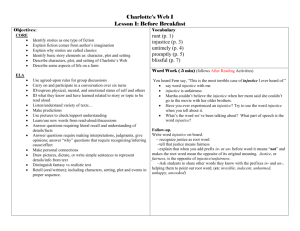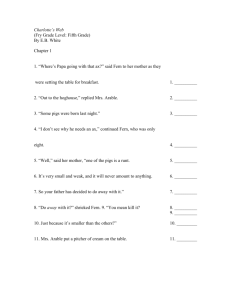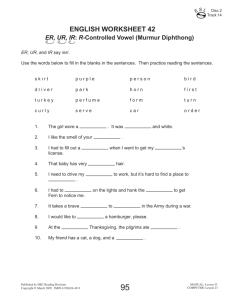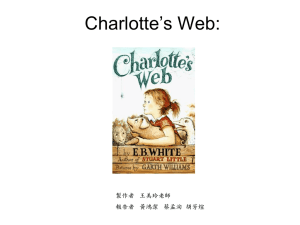Charlotte's Web Unit
advertisement
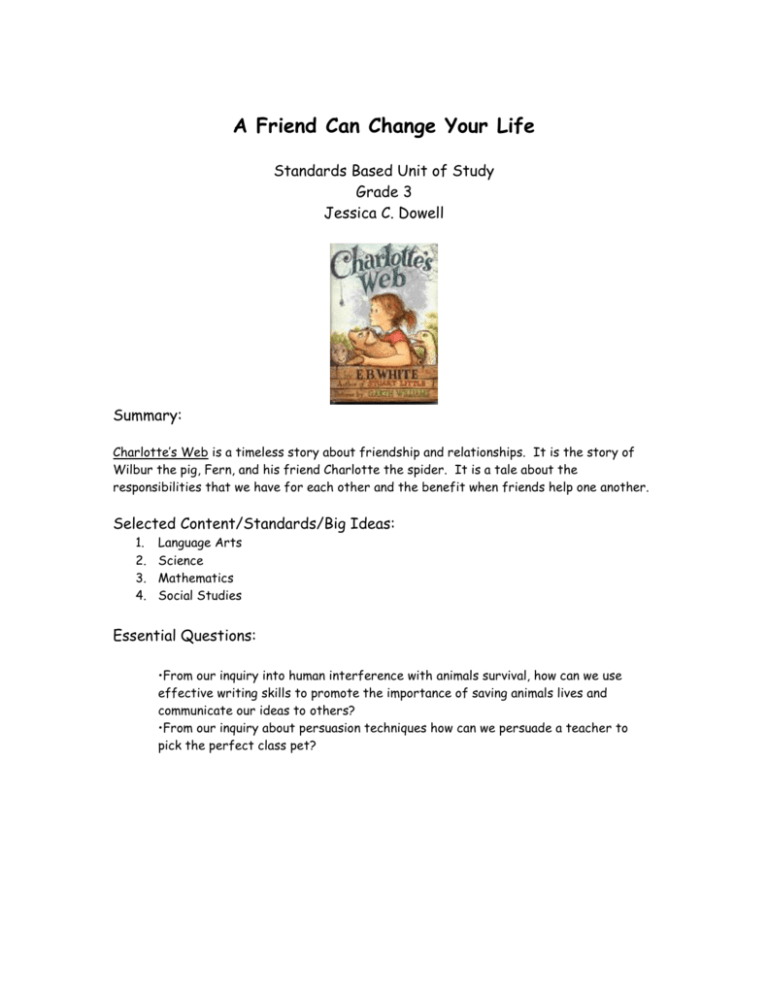
A Friend Can Change Your Life Standards Based Unit of Study Grade 3 Jessica C. Dowell Summary: Charlotte’s Web is a timeless story about friendship and relationships. It is the story of Wilbur the pig, Fern, and his friend Charlotte the spider. It is a tale about the responsibilities that we have for each other and the benefit when friends help one another. Selected Content/Standards/Big Ideas: 1. 2. 3. 4. Language Arts Science Mathematics Social Studies Essential Questions: •From our inquiry into human interference with animals survival, how can we use effective writing skills to promote the importance of saving animals lives and communicate our ideas to others? •From our inquiry about persuasion techniques how can we persuade a teacher to pick the perfect class pet? Language Arts: (WR-EP-1.1.3; WR-EP-1.2.0; WR-EP-1.2.3; WR-EP-2.3.3; WR-EP-2.4.0; WR-EP-2.4.3; WR- EP-3.6.0) ACTIVITES: 1. Have students conduct a “pig interview”. Brainstorm as a class what questions to ask a pig. Group students in pairs. One takes the role of reporter and one as the pig. Switch roles. Students will give an oral report or write a newspaper article of their interview. 2. Make a story map to determine the setting, characters, problem, and solutions for the story. 3. Make a character web. Have students choose a character from the story and put in the middle of the web. From the spokes of the web write words that describe that character. Science: (SC-EP-3.4.1; SC-EP-3.4.2; SC-EP-3.4.3; SC-EP-4.6.1; SC-EP-4.7.1) ACTIVITIES: 1. Compare the differences in insects and spiders. Design a worksheet that teaches the differences. 2. Explain the Life Cycle of a spider. 3. Make an animal babies booklet for younger students. Make a list of common farm animals. Find the name of the animal babies. (example-horse/foal, cow/calf) Draw pictures for the animals. 4. Brainstorm the ways Fern took care of Wilbur. Have students name their pets. As a whole class or in cooperative groups discuss other ways to care for pets. Have students record on a chart organizing the information about the pet, its food, habitat, exercise, and other ways to care for pets. Mathematics: (MA-EP-1.3.1; MA-EP-2.2.2a; MA-EP-5.1.1) ACTIVITES: 1. Make a timeline to show important events of the story. 2. Create a math game using blue ribbons as the pattern for the game cards. Write word problems about the story on the cards. Design a game board using scenes from the book. 3. Plan a vacation day like Wilbur’s and make a calendar and schedule. 4. Use recipes to create some prize-winning dishes. Brainstorm with the whole class how to plan a lunch for the class. Discuss what will be needed. Make list of needed items. Five word problems related to the situation. Use conversation of recipes as an activity. Model for students how to convert a lemonade recipe for serving six, to enough for a whole class. Discuss each step. Divide into groups give each group a simple recipe to convert. Review each group’s work as a class. Put on the lunch with each group bringing the needed items. Social Studies: (SS-EP-2.1.1) ACTIVITIES: 1. Have students think about ways city life and country life. Create a Venn Diagram to illustrate their differences and similarities. 2. Students can create 3-D farm scenes with an explanation of what is being illustrated and why it is important. 3. Make a map of Wilbur’s escape route at Zuckerman’s Farm. Include a legend. 4. Problem-solving: Charlotte worked hard at the problem of how to save Wilbur’s life. Brainstorm some ways to solve some common classroom problems. Put students in groups and have them create skits to role-play for the class illustrating on how to resolve the conflict. Learning Events/Instructional Strategies Reading/Writing Workshop •Engagement and pre-reading activities (powerpoint and anticipation guide) •Literary and transactive reading – independent and collaborative (reading circles); teacher read alouds •Reading responses – prompts directed toward core content and essential questions (written/oral) •Mini lessons related to reading, as needed (vocabulary/text structure emphasis) •Writing-to-learn activities •On-demand writing/persuasive focus •Open Response/multiple choice questions/comprehension focus Assessment/Evaluation •Reading Journal, Reading Circle and Open Response rubrics •Student designed scoring rubrics •Teacher Observation •CATS like assessments: ORQ and OD writing Resources Charlotte’s Web by E. B. White Earring’s by Judith Viorst Inquiry Web Resources (samples) •http://www.pickens.k12.sc.us/hesteachers/laboonac/Web%20Pages/charlotte's%2 0web%20theme.htm •http://www.cape.k12.mo.us/blanchard/hicks/Reading%20Pages/Charlotte's%20We b/Charlottes_Web.htm#Lesson_Plans •http://www.campbellusd.k12.ca.us/Charlotte%27s_Web_Page/index.html •http://www.murrieta.k12.ca.us/alta/dfuller/charlotte/index.html •http://www.sdcoe.k12.ca.us/score/charl/charltg.html •http://edhelper.com/books/Charlottes_Web.html Charlotte’s Web Anticipation Guide Before Reading True or False? After Reading True or False? All runt piglets are killed at birth Fern convinces her father not to kill Wilbur Pigs eat grains and grass Wilbur escapes from Mr. Zuckerman’s barn Wilbur meets an unlikely friend in Mr. Zuckerman’s barn Rats are scavengers and will eat just about anything Charlotte the spider wrote messages in her web about Wilbur Ferns parents believed that animals could talk Wilbur never makes it to the farm festival Spiders live very long lives All pigs are slaughtered for food Pre-Reading Activities Reading/Writing Connections: 1. Preview the book. Show the cover and read the chapter titles. Have students look for any clues that might convey what the story might be about. 2. Discuss farm life with the students. Do they have any ideas on what life on a farm is like? Ask if students ever considered an animal more than just a pet? What could they do if they found a pet that was weak or hurt? 3. Write about the meaning of friendship. What makes a good friend? What do you like best about your best friend? Introduction to Persuasion Unit Read the first chapter. Have students write a letter to Fern’s papa, Mr. Arable persuading him to spare Wilbur’s life. Vocabulary/Spelling anxiety exertion miraculous runt trough appetite genuine miserable scheme ascend humble phenomenon specimen commotion injustice promptly spinneret distribute litter radiant triumph Mini Lessons used to teach vocabulary, text structure, and persuasive writing • • • • • • dialogue (Chapter 1) synonyms and antonyms (Chapter 12) real and fantasy (Chapter 14) prefixes (Chapter 15) multiple meaning words (Chapter 17) Teaching persuasive Writing *What is persuasion? *Good and bad persuasion techniques *Problems and solutions *Lead and closing *Drafting *Editing *Final draft Word Wiz (sample reading response) Chapter 1 Before Breakfast There are some interesting words in this chapter: (page 3) “This is the most terrible case of injustice I ever heard of.” In this part of the story Fern is trying to convince her dad not to kill Wilbur the piglet runt. I agree with Fern that it would be wrong to kill the pig. (page 3) “You go back to the house and I will bring the runt when I come in. I’ll let you start it on a bottle, like a baby. Then you’ll see what trouble a pig can be.” A runt means that the piglet is small, weak, and will probably die anyway. (page 5) “No, I only distribute pigs to early risers.” This word means to give to or give out. (page 4) “You call that miserable thing a pig?” Avery was being mean when he called Wilbur miserable. The little pig can’t help that he was born weak and small. I don’t think I like Avery very much. (page 5) “That’s a fine specimen of a pig—it’s no bigger than a white rat.” Once again Avery is acting ugly making fun of Wilbur. This confirms that I don’t like this Avery character. (page 5) “It just shows what can happen if a person gets out of bed promptly!” I guess when Avery’s dad uses this word he is meaning that “the early bird gets the worm”. (page 7) The pig, although tiny, had a good appetite and caught on quickly. This means that the pig was hungry and wanting to eat. Summarizer (sample reading response) Chapter 1 Before Breakfast This chapter begins by a runt piglet being born. Mr. Arable plans on killing the runt because it is weak and small. Fern who is Mr. Arable’s daughter gets very upset when she hears of this and runs to stop her dad from killing the pig. Fern convinces her dad not to kill the pig and promises that she will take care of the pig. Fern’s brother Avery says that the pig is miserable and is no bigger than a rat. Fern doesn’t seem to care what Avery says and she gives the pig warm milk with a bottle before heading off to school. She decides to name the pig Wilbur and blurts the name out in class while daydreaming. Mr. Arable must be a really nice dad to let Fern keep the runt pig. I am so glad that he did not kill the runt piglet. Fern must feel really good that her parents think she is responsible enough to take care of the pig. I think that in the story Avery will be a troublemaker. He seems to have a negative attitude and acts like he will pick on his little sister. This story will probably take place on a farm since there is a hoghouse. Interpreter (sample reading response) Chapter 1 Before Breakfast Mr. Arable “Papa” is being characterized as an understanding father who cares about his daughter’s feelings and wishes. He was going to kill the runt piglet but didn’t because Fern thought he was being unfair. Fern is being characterized as a little girl who speaks her mind about her opinions and beliefs. When she hears her papa is going to kill the runt piglet she immediately runs out to stop her papa from killing the piglet. Avery is being characterized as a boy who likes to play outside and pick on his sister. He thinks that it is a miserable pig. By his actions I don’t think he will help Fern take care of the pig. Mrs. Arable is being characterized as a mother and wife who lives on the farm. She seems really nice to let Fern keep the piglet and help her get the milk for Fern to feed the piglet. Connector (sample reading response) Chapter 1 Before Breakfast I know that taking care of a baby animal can be a big responsibility. Fern is taking on a big responsibility because she will have to feed the piglet in the morning before school and when she returns home after school. She will have to make sure all of the pigs needs are met as far as food, water, and shelter. Taking care of any animal is a big responsibility. Fern’s parents must truly believe in her to give her the responsibility of raising a pig. This story appears that it will take place on a farm so I think we will be reading about many different farm animals and the relationships they have with each other and the people around them. Literary Critic (sample reading response) Chapter 1 Before Breakfast The comparison Avery gives when he says “that’s a fine specimen of a pig—it’s no bigger than a white rat” really helps me visualize the size of this runt piglet that Fern wants to keep. The author uses very descriptive language in this first chapter to help me visualize what’s going on in the story. The author also includes lots of dialogue that helps me connect with how the characters are feeling. I feel like I want to yell at Mr. Arable with Fern saying, “Don’t kill that pig!” Reading Response Journal Prompts Major Focus: A friend can change your life. Core Content: Reflecting and responding to text. Demonstrating a critical stance. Connecting information to students’ lives and/or real world issues. 1. 2. 3. 4. 5. 6. 7. 8. 9. 10. 11. Beginner Learner Skillful Expert Fern felt that her father was doing the wrong thing to kill the runt piglet. How do you feel? Who was right, Fern or her father? Explain your answer. Compare Fern’s job of caring for Wilbur with that of caring for another animal or baby. What could have happened if Wilbur had not been caught so soon after his escape? Write a story of Wilbur’s one day of freedom on the farm. What other animals could he have met? What adventures could he have done? Make a list of things you save. How do you organize them? Have you ever told a true story and nobody believed you? Write the story you told and then tell what happened when you told other people. Charlotte coached Wilbur by giving him directions. Write out directions for someone to follow. Make the task simple and the directions clear. Your task should require 3-5 steps. Charlotte calls a meeting of all the barnyard animals to help her think of words to write in her web. Think of some other times that meetings are called. What are the meetings for? How do they help? Mr. Zuckerman has his wife call the reporter from the newspaper. Pretend you are the reporter. Write an article for the newspaper about the web. Templeton roamed the fair, eating all sorts of things he found. Make a list of things he ate. Then pretend that Templeton was a pet rat. What would he eat then? Compare the two menus. Wilbur and Charlotte trusted Templeton to get the egg sac. Would you trust Templeton? Explain your answer. What makes a good friend? Make a list of qualities you value in a good friend. Rubric for Reading Journals __ Response shows a minimal understand of the response prompt __ Responses shoes no information from the story as support for answer __ Errors in spelling, punctuation, and capitalization that are confusing __ Response shows a basic understanding of the response prompt __ Response uses limited information from the story as support for answer __ Some errors in spelling, punctuation, and capitalization that are not confusing __ Response shows an understanding of the response prompt __ Response uses information from the story to support answer __ Few errors in spelling, punctuation, and capitalization __ Response shows an in-depth understanding of the response prompt __ Response is insightful, well developed and includes information from the story as support __ Control of spelling, punctuation, and capitalization Open Response/Multiple Choice The Runt of the Litter Read the following passage from Charlotte’s Web and think about what Mr. Arable is getting ready to do and how Fern reacts to this situation. “Where’s papa going with that ax?” said Fern to her mother as they were setting the table for breakfast. “Out to the hoghouse,” replied Mrs. Arable. “Some pigs were born last night.” “I don’t see why he needs an ax,” continued Fern, who was only eight. “Well,” said mother, “one of the pigs is a runt. It’s very small and weak, and it will never amount to anything. So your father has decided to do away with it.” “Do away with it?” shrieked Fern. “You mean kill it? Just because it’s smaller than the others?” Mrs. Arable put a pitcher of cream on the table. “Don’t yell Fern!” she said. “Your father is right. The pig would probably die anyway.” Fern pushed a chair out of the way and ran outdoors. The grass was wet and the earth smelled of springtime. Fern’s sneakers were sopping by the time she caught up with her father. “Please don’t kill it!” she sobbed. “It’s unfair.” Mr. Arable stopped walking. “Fern,” he said gently, “you will have to learn to control yourself.” “Control myself?” yelled Fern. “This is a matter of life and death, and you are talking about controlling myself.” Tears ran down her cheeks and she tool hold of the ax and tried to pull it out of her father’s hand. “Fern,” said Mr. Arable. “I know more about raising a litter of pigs than you do. A weakling makes trouble. Now run along!” “But it’s unfair,” cried Fern. “The pig couldn’t help being born small, could it? If I had been very small at birth, would you have killed me?” Mr. Arable smiled. “Certainly not,” he said looking down at his daughter with love. “But this is different. A little girl is one thing, a little runty pig is another.” “I see no difference,” replied Fern, still hanging on the ax. “This is the most terrible case of injustice I ever heard of.” A queer look came over John Arable’s face. He seemed almost ready to cry himself. “All right.” he said. “You go back to the house and I will bring the runt when I come in. I’ll let you start it on a bottle, like a baby. Then you’ll see what trouble a pig can be.” Multiple Choice 1. The best synonym for the word injustice in the sentence This is the most terrible case of injustice I have ever heard of is: O rightness O honesty O goodness O unfairness 2. The author’s purpose in this passage is to: O introduce the characters O describe a conflict O paint a picture O all of the above 3. What does the word queer mean in the sentence A queer look came over John Arable’s face. O strange O pretty O happy O sad 4. What word is an adjective in the following sentence The pig couldn’t help being born small, could it? O pig O help O small O born Open Response 5. Fern thinks that her father is being unreasonable about getting rid of the smallest pig. He says “A weakling makes trouble.” A. Explain what the phrase means in this story. B. Use examples from the passage in your answer. C. What persuasive method does Fern use? (Fern describes her father’s behavior as injustice to all small and weak. She asks if her own life would have been taken if she were not born an appropriate size. Fern persuades her father by appealing to his emotions.) Open Response/Multiple Choice Using Your Senses Read the following passage from Charlotte’s Web and think about how the author uses his senses to describe the setting of the barn. The barn was very large. It was very old. It smelled of hay and it smelled of manure. It smelled of the perspiration of tired horses and the wonderful sweet breath of patient cows. It often had a sort of peaceful smell—as though nothing bad could happen ever again in the world. It smelled of grain and of harness dressing and of axle grease and of rubber boots and of new rope. And whenever the cat was given a fishhead to eat, the barn would smell of fish. But mostly it smelled of hay, for there was always hay in the great loft up overhead. And there was always hay being pitched down to the cows and the horses and the sheep. The barn was pleasantly warm in the winter when the animals spent most of their time indoors, and it was pleasantly cool in the summer when the big doors stood wide open to the breeze. The barn had stalls on the main floor for the work horses, tie-ups on the main floor for the cows, a sheepfold down below for the sheep, a pigpen down below for Wilbur, and it was full of all sorts of things that you find in barns: ladders, grindstones, pitchforks, monkey wrenches, scythes, lawn mowers, snow shovels, ax handles, milk pails, water buckets, empty grain sacks, and rusty rat traps. It was the kind of barn that swallows like to build their nests in. It was the kind of barn that children like to play in. And the whole thing was owned by Fern’s uncle, Mr. Homer L. Zuckerman. Wilbur’s new home was in the lower part of the barn, directly underneath the cows. Mr. Zuckerman knew that a manure pile is a good place to keep a young pig. Pigs need warmth, and it was warm and comfortable down there in the barn cellar on the south side. Fern came almost every day to visit him. She found an old milking stool that had been discarded, and she placed the stool in the sheepfold next to Wilbur’s pen. Here she sat quietly during the long afternoons, thinking and listening and watching Wilbur. The sheep soon got to know her and trust her. So did the geese, whole lived with the sheep. All the animals trusted her; she was so quiet and friendly. Mr. Zuckerman did not allow her to take Wilbur out, and he did not allow her to get into the pigpen. But he told Fern that she could sit on the stool and watch Wilbur as long as she wanted to. It made her happy just to be near the pig, and it made Wilbur happy to know that she was sitting there, right outside his pen. But he never had any fun—no walks, no riders, no swims. Multiple Choice 1. What are the four senses that are used to describe Wilbur’s new home? O see, hear, smell, taste O see, hear, smell, feel O see, feel, smell, taste O see, smell, feel, taste 2. The author’s purpose in this passage is to: O describe a conflict O describe a character O paint a picture O all of the above 3. What does the word perspiration mean in the sentence It smelled of the perspiration of tired horses and the wonderful sweet breath of patient cows? O flowers O hair O sweat O urine 4. What word is an adjective in the following sentence The barn was very large. O the O barn O was O large Open Response 5. The author describes things in this chapter by referring to the senses. Find and list at least 2 examples of things that the author lets you see, hear, smell, and feel. (The barn smelled of hay, manure, the perspiration or tired horses, the sweet breath of patient cows, grain, harness dressing, axle grease, rubber boots and fish. See: ladders, grindstones, pitchforks, monkey wrenches, scythes. Feel: warm in winter, cool in summer. Hear: the animals, the people yelling, Wilbur eating.) On Demand – Persuasive Techniques SITUATION: Using positive persuasive techniques such as examples listed below can be influential in convincing readers to accept your opinion on an issue or topic. So the more we know about these kinds of persuasive techniques, the more influential we can be. Your school newspaper is going to publish letters by students persuading their teachers to buy a class pet. WRITING TASK: Read the descriptions of positive persuasive techniques below and think about the ones you have used in the past to help your friends and family accept your opinion. Then write a letter to your teacher using these positive persuasive techniques to persuade him/her to buy the class pet you want. Reasons: Facts, details, statistics: Quotes: Personal experience/story: Examples: Explanation of benefits, advantages, and consequences: A statement of reasons and explanation of why your teacher should choose your pet Relevant information that supports your opinion An explanation of what others have said or thought that supports your opinion An explanation of a relevant personal experience you have had with that particular type of pet that helps support your opinion Important examples that help readers see your point of view An explanation of what others stand to gain from choosing your pet


